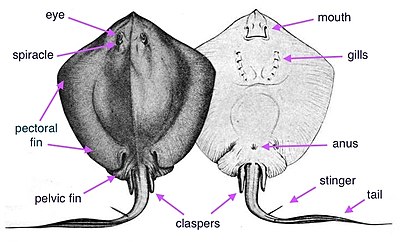| Bluntnose stingray | |
|---|---|

| |
| Scientific classification | |
| Domain: | Eukaryota |
| Kingdom: | Animalia |
| Phylum: | Chordata |
| Class: | Chondrichthyes |
| Subclass: | Elasmobranchii |
| Order: | Myliobatiformes |
| Family: | Dasyatidae |
| Genus: | Hypanus |
| Species: | H. say
|
| Binomial name | |
| Hypanus say (Lesueur, 1817)
| |

| |
| Range of the bluntnose stingray | |
| Synonyms | |
| |

External anatomy of a male bluntnose stingray
The bluntnose stingray or Say's stingray (Hypanus say, often misspelled sayi) is a species of stingray in the family Dasyatidae, native to the coastal waters of the western Atlantic Ocean from the U.S. state of Massachusetts to Venezuela. It is a bottom-dwelling species that prefers sandy or muddy habitats 1–10 m (3.3–32.8 ft) deep, and is migratory in the northern portion of its range. Typically growing to 78 cm (31 in) across, the bluntnose stingray is characterized by a rhomboid pectoral fin disc with broadly rounded outer corners and an obtuse-angled snout. It has a whip-like tail with both an upper keel and a lower fin fold, and a line of small tubercles along the middle of its back.
More active at night than during the day when it is usually buried in sediment, the bluntnose stingray is a predator of small benthic invertebrates and bony fishes. This species is aplacental viviparous, in which the unborn young are nourished initially by yolk, and later histotroph ("uterine milk") produced by their mother. Females give birth to 1–6 pups every May after a gestation period of 11–12 months, most of which consists of a period of arrested embryonic development. The venomous tail spine of the bluntnose stingray is potentially dangerous to unwary beachgoers. The International Union for Conservation of Nature (IUCN) has listed this species as near threatened.[1]
- ^ a b Carlson, J.; Charvet, P.; Blanco-Parra, MP, Briones Bell-lloch, A.; Cardenosa, D.; Derrick, D.; Espinoza, E.; Herman, K.; Morales-Saldaña, J.M.; Naranjo-Elizondo, B.; Pacoureau, N.; Schneider, E.V.C.; Simpson, N.J. (2020). "Hypanus say". IUCN Red List of Threatened Species. 2020: e.T60159A3090316. doi:10.2305/IUCN.UK.2020-3.RLTS.T60159A3090316.en. Retrieved 19 January 2021.
{{cite journal}}: CS1 maint: multiple names: authors list (link)
